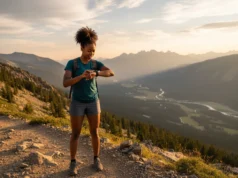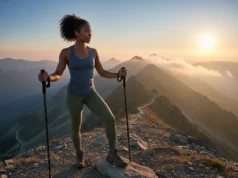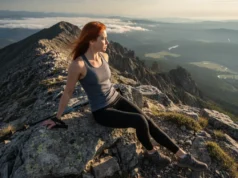In this article
The legendary break neck ridge hike, a rite of passage for countless hikers, is entering a new chapter. Known as one of America’s most popular and challenging day hikes, this iconic Hudson Valley climb is set for a massive two-year transformation beginning in 2025. You’ve come to the definitive resource for navigating this pivotal period. We will cover the full details of the 2025-2027 trail closure, help you discover the best alternative hikes on nearby mountains, and ensure you can master the specific gear and safety protocols needed for Breakneck’s demanding terrain—both now and after its highly anticipated reopening as part of the visionary Fjord Trail project.
CRITICAL ALERT: The 2025-2027 Breakneck Ridge Closure
Here you’ll find the most urgent information about the upcoming trail closure. These details cover exactly what is closed, when, and for how long, ensuring you have the official facts before making any plans for this strenuous hike.
What’s Closing, When, and Why: The Official Details
According to the official announcement from NYS Parks, the Breakneck Ridge trailhead to close for a two-year period will take effect on April 21, 2025. This closure is expected to last for up to two years, placing a potential reopening sometime in 2027. This affects all main access points from the road, including the main white-blazed Breakneck Ridge Trail entrance, the yellow-blazed Wilkinson Memorial trailhead, and the Lower Brook trailhead.
This is not simple maintenance; it’s a complete overhaul of the Breakneck area. The closure facilitates the construction of the Breakneck Connector and Bridge, a cornerstone of the Hudson Highlands Fjord Trail initiative. This major infrastructure project is the direct solution to decades of dangerous conditions—including hiker safety along Route 9D, significant trail erosion from many hikers, and the total lack of visitor amenities.
In conjunction with the trailheads, the dedicated Breakneck Ridge station, a key stop on the MTA Metro-North line, will also close for a full renovation. As confirmed by project leaders at Breakneck.info, all roadside parking near the trailheads and the Breakneck Tunnel on Route 9D will be strictly prohibited. This collaborative project, supported by organizations like the New York-New Jersey Trail Conference, aims to create a safer, more sustainable, and ultimately more accessible experience for the thousands of visitors drawn to this incredible natural landmark each year.
The Ultimate Guide to Breakneck Ridge Alternatives
With the main trailhead closed, the immediate question becomes: “Where should I hike instead?” Find your answer here, with details on how to legally access certain Breakneck viewpoints and a data-driven trail guide to the best alternative hiking trails in the region.
How to (Safely and Legally) Access Breakneck Views During the Closure
While the main trailheads are inaccessible, the mountain itself is not entirely off-limits. The upper trail network of the southern Breakneck Ridge remains open. For experienced hikers, this means it’s still possible to reach the famous multiple cliff overlooks by accessing the trail system from other, more remote starting points. The primary method is via the Washburn/Cornish trailheads, which also serve as the start for the Bull Hill (Mount Taurus) hike. From there, you can navigate the trail network to connect to the yellow-blazed Wilkinson Memorial Trail and approach Breakneck’s summits from the east, well away from the construction.
This is not a beginner route. Attempting this longer, more complex hike route is only for self-reliant hikers with excellent navigation skills. You must carry a physical trail map and compass or a reliable GPS device with the route downloaded. According to guidance from the Putnam County website, this access is permitted, but officials urge hikers to be prepared for a much longer and more strenuous day. You should always have a copy of the download an official trail map before you go.
Top Alternative Hikes: Finding Your Perfect Challenge
To assist hikers during the closure, project leaders have curated an official list of alternative hikes. These trails were chosen to provide a similar character and range of difficulty to Breakneck. For those seeking a comparable rock scramble challenge and intensity, the top recommendations are Bull Hill (Mt. Taurus), Storm King Mountain, and Anthony’s Nose. These strenuous hikes deliver the rugged rocky terrain and rewarding Hudson River vistas that make this valley famous.
For any hiker arriving by train, many superb alternatives are accessible from MTA Metro-North stations. The classic hikes around Bull Hill and the historic Cornish Estate ruins can be reached from the Cold Spring station, while Mount Beacon with its iconic fire tower is a short walk from the Beacon station. All of these options are detailed in the park-approved hiking suggestions. To help you decide, the comparison table below breaks down the key stats and logistical details for each.
Breakneck Ridge Alternatives
Explore these challenging and scenic hikes that offer similar thrills to Breakneck Ridge in the Hudson Valley.
Location & Access
Cold Spring (Train / Car). Parking Limited.
Details & Scramble
4.5 – 5.6 miles / 3-4 hours. Steep, rugged ascent with some scrambling but less exposed than Breakneck.
Location & Access
Cornwall (Car Only). Parking Limited.
Details & Scramble
1.5 – 3.6 miles loops. Steep, rugged trails with excellent views directly across the river from Breakneck.
Location & Access
Garrison (Train / Car). Parking VERY Limited.
Details & Scramble
2.0 – 6.4 miles / 2-3 hours. Features a steep rock “staircase” and rewarding views of the Bear Mountain Bridge.
Location & Access
Beacon (Train / Car). Parking Limited.
Details & Scramble
~4.7 miles / 3 hours. Very steep initial climb to a fire tower with panoramic views. Less technical scrambling.
Location & Access
New Paltz (Car Only). Parking Limited, Fee.
Details & Scramble
2.3 – 5.6 miles options. Features a challenging and fun rock scramble similar to Breakneck intensity.
Location & Access
Cornwall (Car Only). Parking Limited.
Details & Scramble
~7.4 miles loop. Long, rugged ridge walk with significant elevation gain and some rocky sections.
Location & Access
Garrison (Train / Car). Parking Limited.
Details & Scramble
~2.9 miles / 2 hours. Steep and rugged trail leading to excellent river views.
Location & Access
Garrison (Train / Car). Parking Limited.
Details & Scramble
~3.9 miles loop. Mostly flat loop with great river views, ideal for a less strenuous day.
Location & Access
Cold Spring (Train / Car). Parking Limited.
Details & Scramble
~1.8 miles / 1 hour. Casual walk on old carriage roads to historic ruins. No scrambling.
The Definitive Guide to the Breakneck Ridge Hike (For Future Adventures)
For those planning an adventure after the trail reopens in 2027, what follows is the evergreen core of the hike itself. You’ll find a detailed guide to the routes, the on-trail experience, and the key stats to be fully prepared to visit Breakneck Ridge.
The Routes: Choosing Your Loop (Long vs. Short)
The classic Breakneck experience is the Breakneck Ridge Long Loop, a formidable 3.7-mile journey that demands roughly four hours and climbs over 1,400 feet in elevation. This route is defined by its ascent up the relentlessly steep white trail, continuing over multiple summits before a more gradual descent on the longer-but-less-steep Breakneck Bypass trail and the yellow-blazed Wilkinson Memorial Trail. It is the full, unfiltered challenge, involving sections of near-vertical climbing.
For those wanting a taste of the famous fun rock scramble without the full-day commitment, the “Short Loop” is a fantastic hike option. This 1.9-mile route takes about 1.5 to 2 hours. It follows the white-blazed trail up to the first major viewpoint and flagpole before descending via the green-blazed Nimham Trail, an impressive feat of trail engineering featuring over 500 hand-set stone steps. As an NYS Parks manager noted, the Nimham Trail was specifically built to create a safer descent, preventing hikers from attempting to go down against the flow of upward traffic on the steepest sections.
Breakneck Ridge Loop Options
Compare the different hiking loops available at Breakneck Ridge, from the classic challenge to shorter, more manageable options.
Estimated Time
3-4 hours
Elevation Gain
~1,442 ft
Trail Blazes
White → Red → Yellow
Key Features
Full rock scramble, multiple summits, gradual woodland descent
Best For…
The classic, full Breakneck challenge for experienced hikers.
Estimated Time
1.5-2 hours
Elevation Gain
~650 ft
Trail Blazes
White → Green → Yellow
Key Features
Initial rock scramble, main flagpole view, stone-step descent
Best For…
Experiencing the famous scramble with a quicker, safer descent.
Estimated Time
4+ hours
Elevation Gain
~1,400 ft
Trail Blazes
White → Blue
Key Features
Full scramble, ends in town for post-hike food/drinks, ending in a requires walk to train
Best For…
Hikers wanting a point-to-point adventure
Mastering the Logistics: How to Prepare for Your Hike
A safe and rewarding experience on a tough hike like Breakneck is forged long before you reach the trailhead. Proper preparation is non-negotiable. Here, we cover the critical “how-to” details, from transportation and parking to the essential gear you must carry.
Essential Gear: Packing for Breakneck’s Unique Terrain
On Breakneck, your gear choices matter immensely, and footwear is paramount. Proper hiking shoes with high-traction, sticky rubber soles and robust ankle support are non-negotiable. The terrain is a prolonged rock scramble where confident footing on the rock face is everything. Your running shoes are not appropriate for this terrain. Hydration is another critical factor. The ridge is strenuous and completely exposed to the sun, so you must carry a minimum of 2-3 liters of water per person. A hydration reservoir in your backpack is often more convenient than bottles, as it encourages you to sip frequently and stay ahead of dehydration.
Your pack should contain the Ten Essentials, but tailored for this specific challenge. This means prioritizing sun protection, packing extra layers like a windbreaker or rain jacket for the exposed and often windy summit, and carrying a headlamp even on a day hike. Because you will be using your hands extensively, some seasoned hikers prefer climbing gloves for added grip and protection. While some say nothing trekking/hiking poles are needed, they are highly recommended for the downhill descent to reduce the impact on your knees, even if they are a hindrance on the scrambling ascent.
A Pro’s Guide to Safety & Responsible Hiking
Going beyond basic preparation builds your skills and confidence. Learn how to mitigate the specific risks of this steep trail, like potential falling rocks, and apply Leave No Trace principles on a high-traffic rock scramble to protect the environment for every fellow hiker.
Leave No Trace on a High-Traffic Scramble
On a trail as popular as Breakneck, practicing Leave No Trace principles is a shared responsibility that protects the fragile environment. The most critical principle here is to travel on durable surfaces. This means staying on the solid rock path. Stepping onto surrounding soil or vegetation, even to let someone pass, contributes to erosion and widens the trail, causing irreparable damage.
[PRO-TIP] Pack out absolutely everything you pack in. This includes organic waste like apple cores, banana peels, and nut shells. These items can take years to decompose in this alpine environment and, more importantly, they attract wildlife, habituating them to human food and creating dangerous situations for both animals and other hikers.
Respect wildlife by observing from a distance. Never approach or feed any animals you encounter. Be considerate of other hikers by keeping your voice down and letting faster hikers pass at safe locations. When climbing, it is standard etiquette to yield to those coming uphill, as they are working against gravity. Following these simple rules ensures a better, safer, and more sustainable experience for everyone. To learn more, visit the official website where the idea that Leave No Trace is especially important is detailed.
Conclusion: Embrace the Change, Explore the Alternatives
The 2025-2027 Breakneck Ridge closure is a significant but necessary step towards creating a safer and more sustainable trail experience for the future. The closure period offers a perfect opportunity for dedicated hikers to broaden their horizons and explore the wealth of incredible alternative trails in the Hudson Valley, many of which offer similar challenges and rewarding vistas.
Successful and safe hiking, whether on Breakneck in the future or on an alternative trail today, always comes down to thorough planning, proper preparation, and a commitment to responsible, low-impact practices. Always check official sources like the NYS Parks website or Breakneck.info for the latest updates on construction, trail status, and parking before you head out. Hike safe and enjoy the journey.
We encourage you to try one of the fantastic alternative hikes mentioned and share your experience to help fellow hikers discover new adventures!
Frequently Asked Questions about the Breakneck Ridge Hike
How hard is the Breakneck Ridge hike?
It is considered one of the most strenuous day hikes in the region, consistently rated 9/10 or 10/10 for difficulty. The primary challenge is not the mileage but the prolonged, steep, and exposed rock scramble that requires constant use of your hands and feet for climbing, making it a very technical hike.
Is the Breakneck Ridge hike good for beginners?
No, the difficult hike is strongly discouraged for inexperienced hikers, children, or anyone with a significant fear of heights or who is not in excellent physical condition. There are many other rewarding hikes in the Hudson Highlands that are far more suitable for a novice hiker.
What are the best alternatives to Breakneck Ridge during the closure?
For a similar challenge, the best alternatives are Bull Hill (Mt. Taurus) and Storm King Mountain, which offer steep climbs and great hikes with fantastic views. For hikers using public transport, trails accessible from the Cold Spring and Beacon Metro-North stations are the top choices.
Do you have to rock scramble on the Breakneck Ridge trail?
Yes, the signature ascent on the white-blazed trail is almost entirely a hands-and-feet rock scramble, classified as Class 2 with some Class 3 moves. This is the main feature of the hike and is unavoidable on the primary route; there are no “walk-around” paths for the difficult sections on the sheer rock faces.
We are a participant in the Amazon Services LLC Associates Program, an affiliate advertising program designed to provide a means for sites to earn advertising fees by advertising and linking to Amazon.com. As an Amazon Associate I earn from qualifying purchases. We also participate in other affiliate programs. The information provided on this website is provided for entertainment purposes only. We make no representations or warranties of any kind, expressed or implied, about the completeness, accuracy, adequacy, legality, usefulness, reliability, suitability, or availability of the information, or about anything else. Any reliance you place on the information is therefore strictly at your own risk. Additional terms are found in the terms of service.





